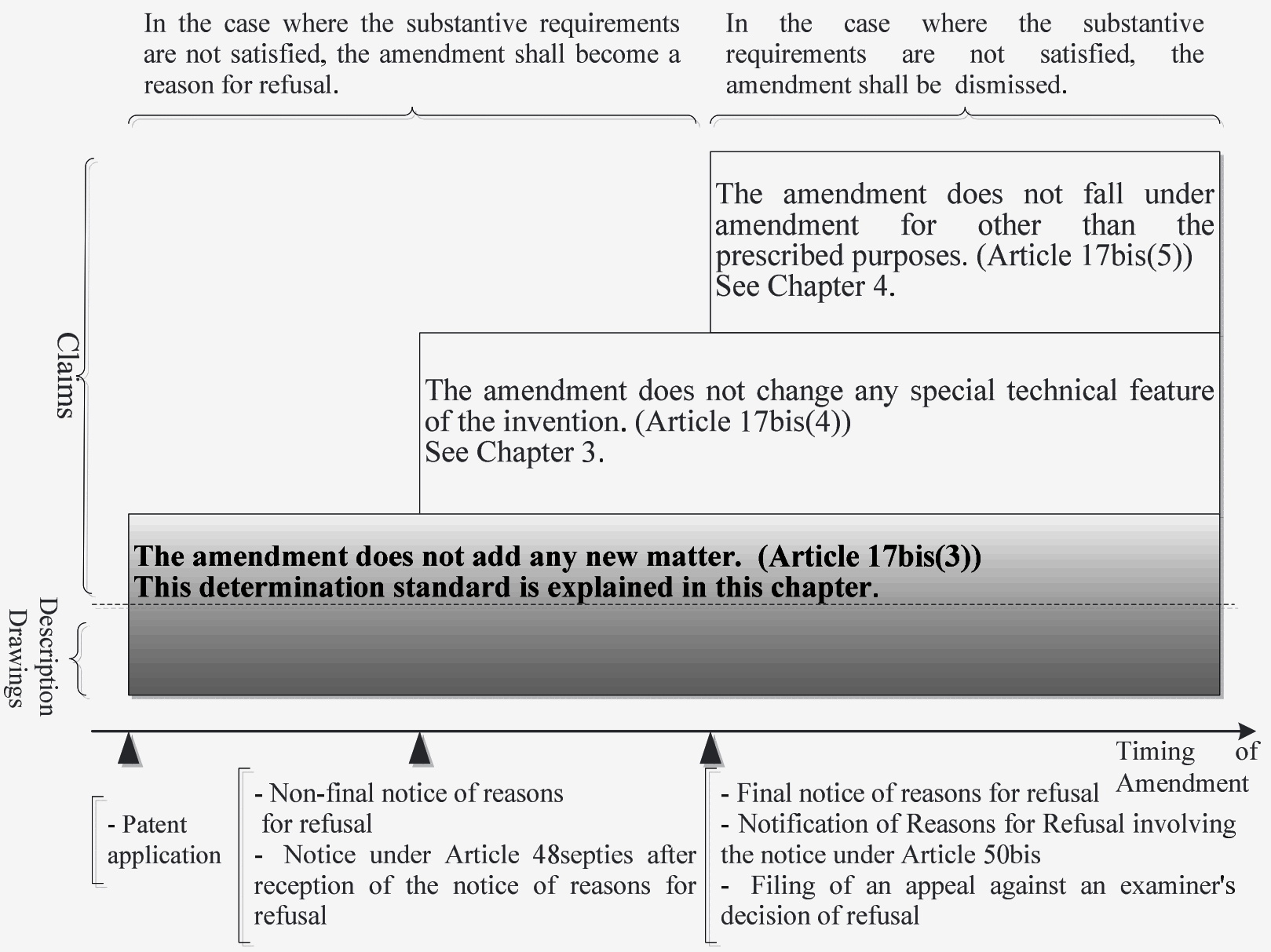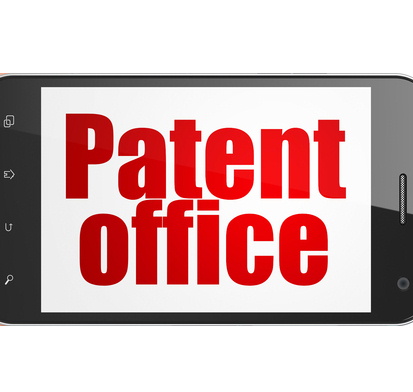Japan Patent Office publishes the Examination Guidelines for Patent and Utility Model. New matter section of the Examination Guidelines is shown below.
Part IV Chapter 2 Amendment Adding New Matter (Patent Act Article 17bis(3))

1. Overview
The Patent Act allows amendment of the description, etc. (see 1. in "Chapter 1 Requirements for Amendments"). However, because the amendment exerts retroactive effects with respect to the filing of the patent application, allowing an amendment having contents beyond the scope of the matters stated in the description, etc. at the time of filing (In this part, hereinafter, referred to as "originally attached description, etc.") after the filing of the patent application would violate the first-to-file principle.
In view of the above, in order to substantially secure the first-to-file principle and balance conflicting interests between the applicant and third parties while allowing amendments for the applicant, Article 17bis(3) of the Patent Act provides that any amendment of the description, etc. shall be made within the scope of the matters stated in the originally attached description, etc. That is, Article 17bis(3) of the Patent Act provides that any new matter shall not be added.
Such a provision shall fulfill the functions of:
(i) securing sufficient disclosure of the invention as of the filing and guaranteeing a prompt grant of right;
(ii) ensuring fairness of handling between a patent application which sufficiently discloses the invention as of the filing and a patent application which does not sufficiently disclose the invention as of the filing; and
(iii) preventing a third party who acted based on the scope of the invention disclosed as of the filing from suffering unexpected disadvantages and reducing a monitoring burden on the third party.
The determination standards on whether an amendment adds any new matter are explained in this chapter.
2. Basic Way of Thinking about Determination on New Matter
The examiner shall determine whether an amendment is an amendment which adds any new matter by determining whether the amendment introduces any new technical matter in connection with "the matters stated in the originally attached description, etc." "The matters stated in the originally attached description, etc." shall refer to technical matter derived by totalizing the whole statement in the originally attached description, etc. by a person skilled in the art.
If an amendment does not introduce any new technical matter in connection with "the matters stated in the originally attached description, etc.," the amendment shall not add a new matter. On the other hand, if an amendment introduces any new technical matter in connection therewith, the amendment shall be an amendment which adds any new matter.
(Reference) A request for reverse of trial decision, Decision by the Intellectual Property High Court, Grand Panel, May 30, 2008 [Heisei 18 (Gyo Ke) No. 10563] "Solder Resist"
"The “matters stated in the description or drawings” are disclosed to third parties by the applicant as a prerequisite for gaining a monopoly based on a patent right for an invention, the highly advanced creation of technical ideas, and such “matters” must be technical matters concerning the invention disclosed in the description or drawings. And the “matters stated in the description or drawings” mean technical matters that a person skilled in the art can understand, taking into account all statements in the description or drawings. Where an amendment does not add any new technical matters to the technical matters that can be understood in this manner, the amendment can be deemed to be made within the “scope of the matters stated in the description or drawings.”
... the matters stated in the description or drawings are usually related to the technical idea disclosed in the description or drawings. Thus, for example, where a correction to add limitations on the claims is to be made for the restriction the claims, if the matters of correction to be added are explicitly stated in the description or drawings, or if they are obvious from such statements, unless there are special circumstances, such correction shall be found to have not added any new technical matters and can be deemed to be made within the “scope of matters stated in the description or drawings.” In practice, this method of determination appears to be appropriate for many cases. "
3. Specific Determination on New Matter
The examiner shall determine whether an amendment is an amendment which adds any new matter, according to a determining method based on each of the following amendment examples 3.1 to 3.3.
3.1 Amendment made to matters explicitly stated in the originally attached description, etc.
In the case where an amended matter is a "matter explicitly stated in the originally attached description, etc.," because the amendment shall not introduce any new technical matter, the amendment shall be permitted. Therefore, the examiner shall determine that, in such cases, the amendment does not add any new matter.
3.2 Amendment made to matters obvious from the statement in the originally attached description, etc.
In the case where an amended matter is a "matter obvious from the statement in the originally attached description, etc.," even if the amended matter is not explicitly stated in the originally attached description, etc., because the amendment shall not introduce any new technical matter, the amendment shall be permitted. Therefore, the examiner shall determine that, in such cases, the amendment does not add any new matter.
In order to find that amended matters are "matters obvious from the statement in the originally attached description, etc.," it is required that a person skilled in the art who contacts the originally attached description, etc. understands the amended matters as if the amended matters were stated in the originally attached description, etc., in light of the common general knowledge as of the filing. The examiner shall take note of the following (i) and (ii) for determining whether the amended matters are "matters obvious from the statement in the originally attached description, etc."
(i) The technology concerning an amended matter cannot sufficiently be considered as a "matter obvious from the statement in the originally attached description, etc." just because the technology itself is well-known art or commonly used art.
(ii) In some cases, a person skilled in the art may understand that an amended matter is obvious from several statements in the originally attached description, etc. in light of the common general knowledge as of the filing. The several statements in the originally attached description, etc. are, for example, a statement of the problem to be solved by the invention and a statement of examples of the invention, or a statement of the description and a statement of the drawing.
Example: The originally attached description, etc. only states a device with an elastic support, and does not disclose a specific elastic support. However, in the case where a person skilled in the art understands that the "elastic support" obviously means a "helical spring" in light of the statement in the originally attached drawings as well as the common general knowledge as of the filing, an amendment which changes the term "elastic support" to a "helical spring" shall be permitted.
3.3 Various amendments
Even in the case where an amended matter does not fall under any of the amendments 3.1 and 3.2 described above, if the amendment does not introduce any new technical matter in view of the “matters stated in the originally attached description, etc.,” the amendment shall be permitted. The examiner shall determine whether an amendment adds any new matter, also in consideration of the cases where the amendment is permitted and the cases where the amendment is not permitted as explained below for each of various amendments.
3.3.1 Amendment of the claims
(1) In the case of an amendment which converts the matters specifying the invention into generic concepts or deletes or changes them
a In the case where an amendment which converts the matters specifying the invention in a claim into generic concepts or deletes or changes them introduces any new technical matter, such an amendment shall not be permitted.
b On the other hand, even in the case of an amendment which converts the matters specifying the invention in a claim into generic concepts or deletes or changes them, particularly, in the case of an amendment which deletes part of the matters specifying the invention in a claim, if it is obvious that the amendment does not add any new technical significance, the amendment does not introduce any new technical matter. Therefore, such an amendment shall be permitted (Example 1).
For example, in the case where a matter to be deleted is not related to a problem to be solved by the invention and is obviously an optional additional matter from the statement in the originally attached description, etc., the amendment does not add any new technical significance in many cases.
(Amendment for deleting part of the matters specifying the invention (Example of paragraph b above))
Example 1: Amendment for changing "an impurity diffusion region that constitutes a source and a drain" to "an impurity region that constitutes a source and a drain" in claims of the invention relating to a compound semiconductor device with a double-hetero structure.
(Explanation)
In this example, the invention claimed in the patent application relates to a semiconductor layer in an active region consisting of a specific structure and material. The original claim unintentionally states that a source and a drain consist of "an impurity dispersion area" in a limited manner. However, the source and the drain are not limited to using dispersion. Any impurity area is sufficient, which is obvious from the statement in the originally attached description, etc., and the amendment does not change the technical significance of the invention at all.
(2) In the case of an amendment which converts the matters specifying the invention into more specific concepts or adds them
a In the case of an amendment which restricts part of the matters specifying - 6 - the invention in a claim and converts it into more specific concepts up to the matters explicitly stated in the originally attached description, etc. or the matters obvious from the statement in the originally attached description, etc., the amendment does not introduce any new technical matter. Therefore, such an amendment shall be permitted.
b Even in the case where an amendment which converts the matters specifying the invention in a claim into more specific concepts is not made up to the matters explicitly stated in the originally attached description, etc. or the matters obvious from the statement in the originally attached description, etc., if it is obvious that the amendment does not add any new technical significance, the amendment does not introduce any new technical matter. Therefore, such an amendment shall be permitted (Examples 2 and 3).
c On the other hand, even in the case of an amendment which converts the matters specifying the invention in a claim into more specific concepts, if matters other than those stated in the originally attached description, etc. are individuated by the amendment, the amendment introduces any new technical matter. Therefore, such an amendment shall not be permitted.
Note that (a) to (c) described above also apply to an amendment which adds the matters specifying the invention in series.
(Amendment for restricting part of the matters specifying the invention (Example of paragraph b above))
Example 2: Amendment for changing "a recording or reproducing apparatus" of claims into "a disc recording or reproducing apparatus."
(Explanation)
In this example, what is stated in the originally attached description, etc. as a specific example is a reproducing apparatus intended for CD-ROMs. Meanwhile, according to another statement in the originally attached description, etc., the present invention is an invention having an object to reduce battery power consumption by adjusting the power supply when the recording and/or reproducing apparatus receives no operation command. Therefore, it is extremely clear that the present invention may be applied to not only a reproducing apparatus intended for CD-ROMs but also any disk recording and/or reproducing apparatus, in light of the content of the another statement in the originally attached description, etc.
Example 3: Amendment for changing the term "work piece" of claims into the term "rectangular work piece."
(Explanation)
In this example, the originally attached description, etc. explicitly states that the subject to be applied by a coating device of the claimed invention is "the work piece" such as glass substrate or wafer. What is stated as a specific example is only an approximately quadrate work piece, but the "rectangular shape" is obviously a typical shape of a typical glass substrate. Therefore, an amendment which changes "the work piece" to "the rectangular work piece" is made within the scope of the matters stated in the originally attached description, etc.
(3) In the case of an amendment which adds or changes numerical limitation
a In the case of an amendment which adds numerical limitation, if the added numerical limitation does not introduce any new technical matter, such an amendment shall be permitted.
For example, if the numerical limitation "preferably 24 to 25 degrees" is explicitly stated in the detailed description of the invention, an amendment for adding said numerical limitation to claims is permitted.
If examples of 24 degrees Celsius and 25 degrees Celsius are stated, this cannot be a direct basis for permitting an amendment which adds the numerical limitation of "24 to 25 degrees Celsius", but it may be perceived, in some cases, that a specific scope of 24 to 25 degrees Celsius is referred to in light of the whole statement in the originally attached description, etc. Examples of such cases include the case where 24 degrees Celsius and 25 degrees Celsius are perceived to be stated as border values of upper limit, lower limit, etc. of a certain consecutive numerical scope in light of the statement of the problem, effect, etc. In this case, unlike cases of absence of an example, it can be evaluated that the numerical limitation was stated originally, and any new technical matter is not introduced. Therefore, such an amendment shall be permitted.
b In the case of an amendment which changes border values of upper limit, lower limit, etc. of a numerical scope stated in a claim to set a new numerical scope, if the following conditions (i) and (ii) are both satisfied, the amendment does not introduce any new technical matter. Therefore, such an amendment shall be permitted.
(i) The border values of the new numerical scope are stated in the originally attached description, etc.
(ii) The new numerical scope is included in the numerical scope stated in the originally attached description, etc.
(4) In the case of an amendment which provides a disclaimer
"Disclaimer" refers to claims explicitly stating exclusion of only part of matters included in the claimed inventions from matters stated in said claims, while leaving the expression of the statement of matters stated in the claims.
"Disclaimer," which excludes matters stated in the originally attached description, etc. through amendment while leaving the expression of the statement of matters stated in claims before amendment, is permitted if the "disclaimer" after exclusion does not introduce any new technical matter. The amendment to provide a "disclaimer" in the following (i) and (ii) does not introduce any new technical matter, and the amendment is permitted.
(i) The amendment to exclude only the overlap in cases where the claimed invention overlaps the cited invention and is thus likely to lose novelty, etc. (Article 29(1)(iii), Article 29bis or Article 39)
(Explanation)
The "disclaimer" in (i) described above refers to a claim explicitly stating exclusion of only matters stated in publications, etc. or the description, etc. of earlier patent applications (including matters which are deemed as being stated therein) as the cited invention relating to Article 29(1)(iii), Article 29bis or Article 39.
The amendment to provide the "disclaimer" in the above-mentioned (i) does not change technical matter introduced from the description, etc. before the amendment at all by excluding specific matters that are contained in the cited invention. It is thus evident that such amendment does not introduce any new technical matter.
In addition, amending claims to provide the "disclaimer" makes them patentable if the invention is remarkably different from the cited invention as the technical idea, and inherently involves an inventive step but the invention accidentally overlaps the cited invention. It is considered that if the invention is not remarkably different from the cited invention as the technical idea, amending claims to provide the "disclaimer" rarely eliminates a reason for refusal for lack of inventive step.
Moreover, if parts of "disclaim" occupy a major portion of the claimed invention or extend to many portions, the examiner shall note that an invention may not be clearly identified from one claim. (See 2.1(1) of "Part II Chapter 2 Section 3 Clarity Requirement ").
Example 4:
[Claims before the amendment] An iron plate washing agent mainly consisting of an inorganic salt containing Na ion as a cation
[Cited Invention] An iron plate washing agent mainly consisting of an inorganic salt containing CO3 ion as an anion
(Specific example: A cation is Na ion)
(Explanation)
In this case, an amendment which changes the claims to "... an inorganic salt containing Na ion as a cation (excluding cases where an anion is CO3 ion)" for the purpose of excluding the overlapping matters with the cited invention from the claims shall be permitted.
(ii) In the case where the claimed invention includes the term "human being" and thus does not fulfill the requirement of the main paragraph of Article 29(1) or falls under the category of unpatentable invention under Article 32, an amendment which excludes only the term "human being"
(Explanation)
The amendment to provide the "disclaimer" in the above-mentioned (ii) to exclude "human being" from the subject of invention to eliminate said reason for refusal does not change the technical matter introduced from the description, etc. before amendment at all. It is thus evident that such amendment does not introduce any new technical matter.
Example 5:
[Claims before the amendment] A mammal characterized in that a polynucleotide having DNA Sequence No. 1 is introduced into the somatic chromosomes and that the polynucleotide is expressed in its somatic cells
(Explanation)
In this case, "a mammal" includes human beings unless the detailed description of the invention makes it clear that "a mammal" does not include human beings. However, an invention that includes human beings themselves as its subject falls under an invention that is likely to harm public order and morality, and it breaches Article 32.
In this case, an amendment for changing the claim to "mammals excluding human beings ..." in order to exclude human beings from the claim is permitted even if the original description, etc. did not state that human beings can be excluded from the subject of the invention.
(5) In the case of an amendment made to a claim in an alternative form such as a Markush form
a In a claim written in an alternative form such as the Markush-Form, an amendment for removing part of the alternatives is permitted if the remaining matters used to specify the invention do not introduce any new technical matter.
b In the case where the originally attached description, etc. includes combinations of many alternatives for stating a chemical substance, it may not be perceived that a combination of specific alternatives added or left by the following amendment (i) or (ii) does not introduce any new technical matter.
(i) An amendment which adds a combination of specific alternatives to a claim within the scope of the many alternatives stated in the originally attached description, etc.
(ii) An amendment which leaves a combination of specific alternatives in a claim as a result of the deletion of alternatives
For example, if a substituted group that had several alternatives as of the filing has only one alternative as a result of the amendment and has no room for change, the amendment is not permitted except when employing a combination of such specific alternatives has been stated in the originally attached description, etc. (see an example of (c) below). This is because the original statement as alternatives would not mean employing a specific alternative.
c On the other hand, if an alternative has been removed so that an alternative accompanied by an example statement is all that remains, it may be found that the remaining alternative does not introduce any new technical matter in view of the whole statement of the originally attached description, etc. including the example.
For example, if a group of chemical substances in a form of a combination of substituted groups with several alternatives is stated in the originally attached description, etc., an amendment for leaving only the statement of the (group of) chemical substances consisting of the combination of specific alternatives corresponding to "a single chemical substance" that was stated in an example, etc. in the originally attached description is permitted.
3.3.2 Amendment of the description
(1) In the case of an amendment which adds contents of a prior art document
a Pursuant to Article 36(4)(ii), the prior art document information (the name of a publication in which the relevant invention is stated and the location of other information concerning the invention known to the public through the publication) is required to be stated (see 2.2.1 and 2.3.1 in “Part II Chapter 1 Section3 Requirements for Disclosure of Information on Prior Art Documents”). An amendment which falls under any of the following amendments (i) and (ii) does not introduce any new technical matter. Therefore, such an amendment shall be permitted.
(i) An amendment which adds the prior art document information to the detailed description of the invention
(ii) An amendment which adds contents stated in the document to "Background Art" of the detailed description of the invention
b However, an amendment which falls under any of the following amendments (i) and (ii) introduces any new technical matter. Therefore, such an amendment shall not be permitted.
(i) An amendment which adds information on evaluation of the invention, such as comparison with the invention claimed in the patent application, or information on implementation of the invention
(ii) An amendment which adds contents stated in the prior art document to eliminate violation of Article 36(4)(i)
(2) In the case of an amendment which adds effects of the invention
a In general, an amendment which adds effects of the invention introduces any new technical matter. Therefore, such an amendment shall not be permitted.
b However, in the case where the originally attached description, etc. explicitly states the structure, operation, or function of the invention and where effects of the invention are obvious from this statement, an amendment which adds the effects of the invention does not introduce any new technical matter. Therefore, such an amendment shall be permitted.
(3) In the case of an amendment which resolves a mismatch statement
If two or more kinds of inconsistent statements are present in the description, etc. and it is evident to a person skilled in the art from the statement of the originally attached description, etc., which of them is correct, an amendment for matching it with the correct statement is permitted, since the amendment does not introduce any new technical matter.
(4) In the case of an amendment which clarifies an unclear statement
If the statement is not in itself unclear but its original meaning is evident to a person skilled in the art from the statement of the originally attached description, etc., an amendment for making it clear is permitted since the amendment does not introduce any new technical matter
(5) In the case of an amendment which adds a specific example
In general, an amendment which adds a specific example of the invention introduces any new technical matter. Therefore, such an amendment shall not be permitted.
For example, in a patent application for a rubber composition consisting of several ingredients, an amendment for adding information that "a specific ingredient may be added" is not permitted in general.
Similarly, an amendment for adding information that "a helical spring may be used as an elastic support" is not permitted when the originally attached description, etc. describes a device that has an elastic support without disclosing a specified elastic support in general.
(6) In the case of an amendment which adds an irrelevant or inconsistent matter
An amendment which adds a matter irrelevant to or inconsistent with the matters stated in the originally attached description, etc. introduces any new technical matter. Therefore, such an amendment shall not be permitted.
Example 6: An amendment which adds the statement "In general, in order to freely insert a fishing line into a hole, it is preferable to secure a large region for the hole. If a hole which is long in the width direction of a rod pipe is provided to a portion of the rod pipe, the strength of this portion significantly decreases. Meanwhile, if a long hole which is long in the axial direction of the rod pipe is provided and this enables the hole to be larger, the decrease in strength can be prevented." to the detailed description of the invention
(Explanation)
In this example, the originally attached description, etc. states that a long hole which is long in the axial direction of a rod pipe is provided to the rod pipe on the premise that a tubular guide for inserting a fishing line into the rod pipe is fitted in the rod pipe. Since there is no room for the adoption of a long hole which is long in the width direction as a long hole for fitting the tubular guide in the first place, the comparison in strength with the long hole which is long in the width direction is irrelevant to the matters stated in the originally attached description, etc. Therefore, the amended matter is irrelevant to the technology stated in the originally attached description, etc., and this amendment adds a new matter.
4. Procedures of Examination concerning Determination on New Matter
The procedures of examination concerning a determination on a new matter shall be as follows. At the time of proceeding with the examination, also see 4. in “Chapter 1 Requirements for Amendments" , " Part I Chapter 2 Section 4 Handling of Written Opinion, Written Amendment, etc." and " Part I Chapter 2 Section 6 Decision of Dismissal of Amendment ."
(1) In the case where the examiner is convinced that an amendment does not introduce any new technical matter with reference to 3. , the examiner shall proceed with the examination on the premise that the amendment does not add any new matter.
(2) In the case where the examiner is convinced that an amendment introduces any new technical matter with reference to 3. , the examiner shall issue a notice of reasons for refusal or a decision to dismiss the amendment to the effect that the amendment adds any new matter. At the time of issuing the notice of reasons for refusal or the decision to dismiss the amendment, the examiner shall point out an amended matter which is determined to introduce any new technical matter, and specifically explain the reasons therefor.
(3) Even in the case where an amendment does not fall under any of the following cases (1) and (2) but falls under either (i) or (ii), the examiner shall determine that the amendment adds any new matter and issue a notice of reasons for refusal or a decision to dismiss the amendment.
(i) The case where the amendment does not fall under any of the situations where the amendment is permitted as explained in 3..
(ii) The case where there is no explanation from the applicant and accordingly where the correspondence relation between the content of the amendment and the matters stated in the originally attached description, etc. is not known
At the time of issuing the notice of reasons for refusal or the decision to dismiss the amendment, the examiner shall specifically explain the reasons why the amendment falls under any of the cases (i) and (ii) described above.
In response to the notice of reasons for refusal, the applicant may make a specific argument or clarification on the fact that the amendment does not introduce any new technical matter, for example, the fact that the amendment falls under any of the situations where the amendment is permitted as explained in 3. . As a result, in the case where the examiner becomes convinced that the amendment does not introduce any new technical matter, the reasons for refusal shall be resolved. In the case where the examiner does not become convinced that the amendment does not introduce any new technical matter, the examiner shall issue a decision of refusal based on the reason for refusal to the effect that the amendment adds any new matter.
5. Points to note
(1) Even an amendment of the drawings shall be permitted unless the amendment introduces any new technical matter. However, the examiner should note that any new technical matter is generally introduced into the drawings after the amendment in many cases. In particular, in the case where photographs attached to the application, etc. instead of drawings are replaced after filing of the patent application, such an amendment may introduce any new technical matter, and hence the examiner should note such a case. An examiner shall notice that drawings do not always reflect the actual dimension
(2) A priority certificate (Note) is not included in the description, etc. Therefore, the examiner cannot make determination on whether the amendment adds any new matter based on the priority certificate.
(Note) A priority certificate in cases of priority under the Paris Convention, etc. provided in Article 43(2), 43bis(1) and 43ter, or filing documents of an earlier application in case of an internal priority provided in Article 41.











